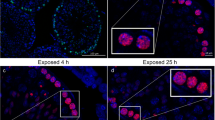Abstract
Objective
Present study is aimed to investigate the anatomical and histopathological changes in liver tissues of Swiss albino male mice, one month after intravenous administration of thorium (232Th; 4 and 40 mg/kg).
Methods
Synchrotron X-ray micro-CT imaging, CD31 immuno-cytochemistry, hematoxylin & eosin staining and Periodic acid-Schiff staining were performed to study changes in liver anatomy, blood vessels/capillaries, histology and glycogen content of liver, respectively.
Results
Synchrotron X-ray micro-CT imaging of liver showed loss of blood vessels in mice treated with thorium (4 mg/kg), which was more prominent at higher dose of thorium (40 mg/kg). These thorium-induced changes in liver were correlated with the decrease in CD31 positive cells and loss of tissue architecture. A dose-dependent increase in glycogen content was also observed in the liver of thorium-treated mice.
Conclusion
Our results provide novel insight about the effects of thorium on liver, which may have significant implications in understanding the mechanism of thorium thorium-induced hepatotoxicity.
Similar content being viewed by others
References
Raina, V. K. et al. Critical facility for lattice physics experiment for the advanced heavy water reactor and the 500 MWe pressurized heavy water reactor. Nucl. Eng. Des. 236, 758–769 (2006).
Kumar, C. et al. Relevance of radiobiological concepts in radionuclide therapy of cancer. Int. J. Radiat. Biol. 92, 173–186 (2016).
Yadav, R. et al. Mechanism of carcinogenesis after exposure of actinide radionuclides: Emerging concepts and missing links. J. Radiat. Can. Res. 8, 20–34 (2017).
Campos, M. P. & Pecequilo, B. R. S. Thoron exposure for workers with naturally occurring radioactive materials. Int. J. Low. Radiat. 4, 53–60 (2007).
Dang, H. S. et al. Studies on intake and body fluid concentration of thorium for subjects working and living in thorium rich environments. J. Radioanal. Nucl. Chem. 243, 513–516 (2000).
Juliao, L. M. et al. Determination of 238U, 234U, 232Th, 228Th, 228Ra, 226Ra and 210Pb concentration in excreta samples of inhabitants of a high natural background area. Radiat. Prot. Dosimetry 105, 379–382 (2003).
Modna, D. K. et al. Thorium in the workplace measurement intercomparison. Appl. Radiat. Isot. 53, 265–271 (2000).
Ulsh, B. A. et al. Establishing bounding internal dose estimates for thorium activities at Rocky Flats. Health Phys. 95, 81–88 (2008).
Zapadinskaia, E. E., Gasteva, G. N. & Titiova, I. N. Analysis of health state in individuals exposed to thorium and chemical hazards in occupational environment. Med. Tr. Prom. Ekol. 11, 14–19 (2005).
Ishikawa, Y. et al. Revised organ partition of thorium- 232 in thorotrast patients. Radiat. Res. 152, S102–S106 (1999).
Kumar, A. et al. Thorium-induced oxidative stress mediated toxicity in mice and its abrogation by diethylenetriamine pentaacetate. Int. J. Radiat. Biol. 84, 337–349 (2008).
Kumar, A. et al. Thorium-induced neurobehavioural and neurochemical alterations in Swiss mice. Int. J. Radiat. Biol. 85, 338–347 (2009).
Ansoborlo, E. et al. Review of actinide decorporation with chelating agents. C. R. Chimie 10, 1010–1019 (2007).
Bilderback, D. H., Elleaume, P. & Weckert, E. Review of third and next generation synchrotron light sources. J. Phys. B At. Mol. Opt. Phys. 38, 773–797 (2005).
Papadimitropoulos, A. et al. Comparative study of desktop- and synchrotron radiation-based micro computed tomography analyzing cell-seeded scaffolds in tissue engineering of bone. in Procee SPIE - The International Society for Optical Engineering. 7080, 10.1117/12.797427 (2008).
Bravin, A., Coan, P. & Suortti, P. X-ray phase-contrast imaging: from pre-clinical applications towards clinics. Phys. Med. Biol. 58, doi: 10.1088/0031-9155/58/1/ R1 (2013).
Agrawal, A. K. et al. Design, development and first experiments on the X-ray imaging beamline at Indus-2 synchrotron source RRCAT, India. J. Synchrotron Radiat. 22, 1531–1539 (2015).
Snigirev, A. et al. On the possibilities of X-ray phase contrast imaging by coherent high-energy synchrotron radiation. Rev. Sci. Instrum. 66, 5486–5492 (1995).
Agrawal, A. K. et al. Synchrotron-based X-ray microimaging facility for biomedical research. J. Radiat. Can. Res. 8, 153–159 (2017).
Schneider, C. A., Rasband, W. S. & Eliceiri K. W. NIH Image to ImageJ: 25 years of image analysis. Nat. Methods 9, 671–675 (2012).
Baratta, J. L. et al. Cellular organization of normal mouse liver: a histological, quantitative immunocytochemical, and fine structural analysis. Histochem. Cell Biol. 131, 713–726 (2009).
ATSDR. Toxicological Profile for Thorium, https://www.atsdr.cdc.gov/toxprofiles/tp147.pdf (1990).
DACTARI. A database for chemical toxicity and radiotoxicity assesement of radionuclides. CEA, France. http://www.dactari.toxcea.org. (2018).
Desai, S. et al. Molecular Understanding of Growth Inhibitory Effect from Irradiated to Bystander Tumor Cells in Mouse Fibrosarcoma Tumor Model. PLoS ONE. doi.org/10.1371/journal.pone.0161662 (2016).
Kumar, A. et al. Role of membrane sialic acid and glycophorin protein in thorium induced aggregation and hemolysis of human erythrocytes. Biochimie 92, 869–879 (2010).
Simko, V. Alkaline Phosphatases in Biology and Medicine. Digest. Dis. 9, 189–209 (1991).
Samuel, V. T. & Shulman, G. I. Mechanisms for insu lin resistance: common threads and missing links. Cell 148, 852–871 (2012).
Evans, R. W., Littler, T. R. & Pemberton, H. S. Glycogen Storage in the Liver in Diabetes Mellitus. J. Clin. Pathol. 8, 110–113 (1955).
Wang, D. et al. Immunohistochemistry in the evaluation of neovascularization in tumor xenografts. Biotech. Histochem. 83, 179–189 (2008).
Hoheisel, M. Review of medical imaging with emphasis on X-ray detectors. Nucl. Instrum. Methods Phys. Res. A 563, 215–224 (2006).
Sun, Z. The Promise of Synchrotron Radiation in Medical Science. Australas Med. J. 1, 1–5 (2009).
Kak, A. C. & Slaney, M. in Principles of Computerized Tomographic Imaging (Society of Industrial and Applied Mathematics, USA, 2001).
Limaye, A. & Drishti. A volume exploration and presentation tool, https://www.spiedigitallibrary.org/conference-proceedings-of-spie/8506/85060X/Drishti-a-volume-exploration-and-presentation-tool/10.1117/12.935640.short?SSO=1 (2012).
Author information
Authors and Affiliations
Corresponding author
Rights and permissions
About this article
Cite this article
Yadav, R., Agrawal, A.K., Ali, M. et al. Thorium-induced Anatomical and Histopathological Changes in Liver of Swiss Mice. Toxicol. Environ. Health Sci. 10, 97–106 (2018). https://doi.org/10.1007/s13530-018-0352-6
Received:
Revised:
Accepted:
Published:
Issue Date:
DOI: https://doi.org/10.1007/s13530-018-0352-6




